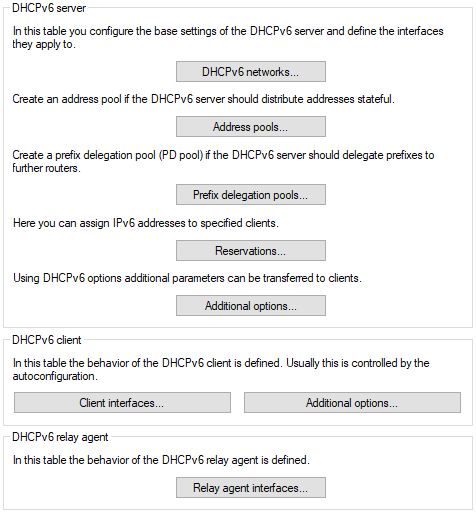Compared to IPv4, clients in an IPv6 network do not require automatic address assignment from a DHCP server because they use auto-configuration. However, because certain information such as DNS server addresses are not transmitted during auto-configuration, certain application scenarios can benefit from a DHCP service on the IPv6 network.
DHCPv6 server
The use of a DHCPv6 server is optional for IPv6. In principle, a DHCPv6 server supports two modes:
- Stateless: The DHCPv6 server does not distribute addresses but only information, such as DNS server addresses. Using this method, clients generate their own IPv6 addresses by "stateless address auto-configuration (SLAAC)". This method is particularly attractive e.g., for small networks in order to keep administration efforts to a minimum.
- Stateful: The DHCPv6 server distributes IPv6 addresses, similar to IPv4. This method is more complicated, since a DHCPv6 server has to assign and manage the addresses.
A DHCPv6 server distributes only the options that are explicitly requested by an IPv6 client, i.e. the server only assigns an address to a client if it explicitly requests one.
Additionally, the DHCPv6 server can pass on prefixes to routers for further distribution. This method is referred to as "prefix delegation". A DHCPv6 client must have explicitly requested this prefix, however.
DHCPv6 client
The auto-configuration available with IPv6 networks makes it very easy and convenient to configure the clients.
However, in order for a client to receive additional information, such as a DNS server address, you must configure the device so that it can activate the DHCPv6 client when necessary.
The settings for the DHCPv6 client ensure that a device receiving certain flags in the router advertisement will start the DHCPv6 client, which can then send requests to the DHCPv6 server:
- M flag: If an appropriately configured device receives a router advertisement with the "M flag" set, the DHCPv6 client will request an IPv6 address from the DHCPv6 server along with other information such as DNS server, SIP server and NTP server.
- O flag: With an "O flag", the DHCPv6 client requests the DHCPv6 server for information such as a DNS server, SIP server and NTP server only, but not an IPv6 address. Note: If the "M flag" is set, the "O flag" does not necessarily have to be set as well.
Relay agent
A DHCPv6 relay agent forwards DHCP messages between DHCPv6 clients and DHCPv6 servers, which are located in different networks (layer 3).
Lightweight DHCPv6 Relay Agent
A Lightweight DHCPv6 Relay Agent (LDRA) compliant with RFC 6221 enables relay-agent information to be generated and passed between DHCPv6 clients and DHCPv6 servers on layer 2.
In LANconfig, the settings are located under :

